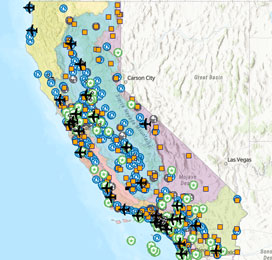Thank you to our
PFAS topic supporter
Have PFAS resource or article to contribute? Email CWEA at [email protected]

Welcome to CWEA’s coverage of PFAS. Polyfluoroalkyl and Perfluoroalkyl compounds, or PFAS for short, are a family of chemical compounds with a’ persistence, ubiquity, and toxicity at very low levels that make them the leading contaminant challenge of our time.
Our coverage of PFAS is supported by Carollo Engineers. Carollo’s experts can help guide you through your challenges with PFAS, including source identification, regulatory tracking, mitigation approaches, funding strategies, and all points in between.
Thank you to our
PFAS topic supporter
Have PFAS resource or article to contribute? Email CWEA at [email protected]
PFAS Primer for Clean Water Professionals (free)
Regulatory Landscape for PFAS in Biosolids and Effluent/Reuse
How PFAS Will Impact Your Pretreatment Program
The Next Wastewater Utility Challenge
Once a year, the small town of Windsor in Northern California hires an external service that specializes in dredging, dewatering, and the beneficial use and disposal of sludge. Over time, the costs of these services have risen. To promote sustainability and establish a net-zero program, the town has decided to explore alternative options. “The District…
On January 14, the U.S. EPA released a Draft Risk Assessment on PFAS in biosolids The draft risk assessment is closed to public comment, but since its release, it has raised questions and concerns with wastewater treatment facility owners and operators. The findings of this assessment do not yet impose any new regulatory limits; however,…
True to the very nature of per- and polyfluoroalkyl substances, commonly referred to as PFAS, these compounds have become pervasive not only in products used in our daily lives but also our conversations surrounding the essential public service of delivering clean water, sanitation, and renewable resources. The most efficient and cost-effective way to move forward…
Understanding PFAS in Wastewater Per- and polyfluoroalkyl substances (PFAS) are pervasive contaminants detectable in all wastewater effluents, even in the absence of direct industrial sources. Water resource recovery facilities (WRRFs) act as passive receivers of these substances. While precursor PFAS compounds often transform into terminal forms detectable in effluent using methods like EPA Method 1633,…
This article explores California’s wastewater and biosolids PFAS data, comparing it to national studies and utilizing artificial intelligence (AI) tools for source analysis investigation. Poly- and perfluoroalkyl substances (PFAS) are a critical class of contaminants due to their widespread presence in the environment and evidence of impacts on human health. Studies have linked certain PFAS…
Representatives from Jurupa Community Services District (JCSD) took part in a critical roundtable discussion at the California State Capitol recently, focusing on the pervasive challenges posed by Per- and Polyfluoroalkyl Substances (PFAS). Representing JCSD were General Manager Chris Berch and Manager of Government & Public Affairs Arman Tarzi. The roundtable of state leaders, invited by…
Per- and polyfluoroalkyl substances (PFAS) are pervasive contaminants detectable in all wastewater effluents, even in the absence of direct industrial sources. Water resource recovery facilities (WRRFs) act as passive receivers of these substances. While PFAS precursor compounds often transform into terminal forms detectable in effluent using methods like EPA Method 1633, WRRFs typically lack the…
Updated on April 19: the U.S. Environmental Protection Agency released both its final rule to classify PFOA and PFOS as hazardous substances under the Comprehensive Environmental Response, Compensation, and Liability Act (CERCLA) and an enforcement discretion memo. This memo shows that EPA does not believe that water systems are the problem. However, the reality of…
Edited by Simona A Bălan and Thomas A Bruton, California Department of Toxic Substances Control; and Kimberly G Hazard, UC Berkeley. From the description: Perfluoroalkyl and polyfluoroalkyl substances (PFASs) are extensively used in consumer products, despite their high persistence and other hazards. The risks posed by this chemical class to human health and the environment,…
CWEA’s coverage of PFAS is supported by Carollo. Advance your career with WEF’s industrial water resources! These peer-reviewed publications provide water quality professionals with essential technical knowledge and strategies. Order yours today! PFAS in the Water and Wastewater Sectors: Fundamentals, Management, and Treatment This collection of essays provides a state of the field on PFAS…
“One of the most effective near- and long-term solutions to reducing PFAS in biosolids is to prevent PFAS from entering wastewater treatment facilities in the first place.” The latest science is clear: long-term exposure to PFAS is linked to significant health risks, and PFAS can enter our water and land through several different paths. That’s…
Coverage of PFAS is supported by Carollo. The toxicity and widespread detectability of certain per- and polyfluoroalkyl substances (PFAS) have raised concern about their potential health impacts or changes to water and wastewater practices in response. PFAS are commonly present in water, human blood, environmental samples, household products, and biosolids (Ducatman et al., 2022; Hu…
As regular readers of my blog are likely aware, this week EPA announced proposed Maximum Contaminant Limits (MCLs) of 4 ppt for PFAS in U.S. drinking water utilities. I’m a social scientist, not a toxicologist or engineer. I can’t speak to health risks or the benefits of regulating PFAS. I can’t address the feasibility of…
View CWEA’s PFAS topics page > Research by Charles E. Schaefer, Jennifer L. Hooper, Laurel E. Strom, Ibrahim Abusallout, Eric R.V. Dickenson, Kyle A. Thompson, Gayathri Ram Mohan, Dina Drennan, Ke Wu, and Jennifer L. Guelfo (please see article for affiliations) Abstract Both quantifiable and semi-quantifiable poly- and perfluoroalkyl substances (PFAS) were evaluated in the…
View CWEA’s PFAS resources page, support by Carollo. Today, the U.S. Environmental Protection Agency (EPA) announced it is seeking public comment on its proposal to address environmental justice, climate change, and PFAS contamination in its National Enforcement and Compliance Initiatives (NECIs). Every four years, EPA selects national initiatives to focus resources on serious and widespread…
Coverage of PFAS is supported by Carollo. In 2018, the media seized on a story about a small dairy farm in Maine that was forced to no longer produce milk due to sludge and biosolids spread on the farm as fertilizer under a state-sponsored program from 1983 to 2004. Wastewater utilities were quickly blamed for…
View CWEA’s PFAS resources page, support by Carollo. PFAS Are Ubiquitous in Our Homes and Our Environment Several recent legislative and regulatory efforts across the US to address PFAS have focused on limiting levels in drinking water. However, there has been relatively little conversation about the presence of these chemicals in our everyday lives. In…
View CWEA’s PFAS resources page, support by Carollo. Three San Francisco Bay Area wastewater agencies are participating in an EPA-funded national research program looking at the prioritization, fate, and transport of unregulated organic chemicals (UOCs) in the environment resulting from land application of biosolids. The three agencies, including the Las Gallinas Valley Sanitary District…
In early 2022, OC San proudly announced they were the first municipal wastewater lab in California accredited to test for PFAS in wastewater. Today, there are 20 labs in California accredited for PFAS testing, OC San and the Inland Empire Utilities Agency are the only approved municipal labs. OC San operates a state-of-the-art Environmental Sciences…
The practice of treating wastewater has existed since the 19th century, beginning with centralized designs to keep sewage discharge out of clean water sources. Around this time, efforts to separate storm runoff from wastewater was also introduced in many communities. Fast forward to today, decades of focus on the environmental impact of waste treatment and…
Mark Kawamoto and his team at Orange County Sanitation District, also known as OC San, are trying to solve a riddle: “How does PFAS make its way into water resource recovery facilities?” PFAS are in wastewater that is treated at water resource recovery facilities (WRRFs), including at OC San’s two facilities, but the source of…
View CWEA’s PFAS resources page, support by Carollo. Exposure to a synthetic chemical found widely in the environment is linked to non-viral hepatocellular carcinoma, the most common type of liver cancer, according to a new study conducted by researchers from the Keck School of Medicine of USC and published in JHEP Reports. These chemicals, which…
View CWEA’s PFAS resources page, support by Carollo. The U.S. Environmental Protection Agency (EPA) released Effluent Guidelines Program Plan 15 (Plan 15), which lays out how the Agency will work to protect the nation’s waterways by following the science and the Clean Water Act to develop technology-based pollution limits and studies on wastewater discharges from…
View CWEA’s PFAS resources page, support by Carollo. It is a fact that chemistry has changed our world for the better. It has played an important role in the production of commercial products, thus making a great variety of raw materials accessible to manufacturers across all industrial sectors and leading to the production of many…
The California Legislature has taken action to limit the use of PFAS in recent years, enacting bills to phase them out of food packaging, banning their use in nearly all firefighting foam, and requiring notification on cookware containing PFAS. Three bills relating to PFAS were passed in the 2022 Legislative Session. The bills included two…
Per- and polyfluoroalkyl substances (PFAS) are ubiquitous, including detectable amounts typically in the parts per trillion (ppt) range in wastewater effluent and parts per billion (ppb) range in solids. The US EPA plans to publish ambient water quality human-health-based criteria for perfluorooctanoic acid (PFOA) and perfluorooctane sulfonic acid (PFOS) by Fall 2024. The EPA also…
Per and polyfluoroalkyl substances (PFAS) are a group of man-made chemicals, often called “forever chemicals” because they are extremely resistant to breaking down and they persist in the environment and the human body, leading to continued exposure and health risks into the future. Despite these problems, PFAS are widely used by industry and are in…
Stories about PFAS have multiplied as we discover more about these “forever chemicals.” They’ve been in our lives since the 1940s – used in clothing, carpets, couches, cookware, cosmetics, and more – but we had no idea until this century that prolonged exposure could be harmful to our health. At least 80 percent of PFAS…
View CWEA’s PFAS resources page, support by Carollo. Welcome to this special edition of CWEA’s winter magazine. Polyfluoroalkyl and Perfluoroalkyl compounds, or PFAS for short, are a family of chemical compounds with a’ persistence, ubiquity, and toxicity at very low levels that make them the leading contaminant challenge of our time. In 2020, the State…
On October 5, 2021, Governor Gavin Newsom signed two bills prohibiting PFAS in juvenile products (AB 652) and disposable food packaging (AB 1200). The two new laws are a part of a trend in PFAS regulation in both California and national food law compliance. The persistence, ubiquity, and uncertainty of the health effects of PFAS have…








